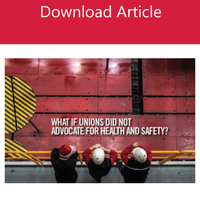Labor unions have pushed for safer and healthier worker conditions for nearly a century, leading up to the Occupational Safety and Health Act in 1970. This legislation marked a "huge turning point that set uniform standards across the country and leveled the playing field for businesses," notes Kevin Riley, research director for UCLA’s Labor Occupational Safety and Health Program.
Among its provisions, the law established a federal agency (the Occupational Safety and Health Administration—OSHA) to enforce worker safety standards. The statistics bear out the agency’s success: between 1970 and 2014, workplace fatalities dropped by two-thirds, from 38 a day to 13.1 One particularly memorable example in which OSHA minimized workplace dangers was at the World Trade Center recovery site after 9/11. Together with labor unions, construction contractors and New York City employees, OSHA collected 6,500 air and bulk samples for testing, and distributed 131,000 respirators, 11,000 hard hats, 13,000 pairs of safety glasses and more than 21,000 pairs of protective gloves to workers on the site.
Read this EIU article, sponsored by Prudential >>







